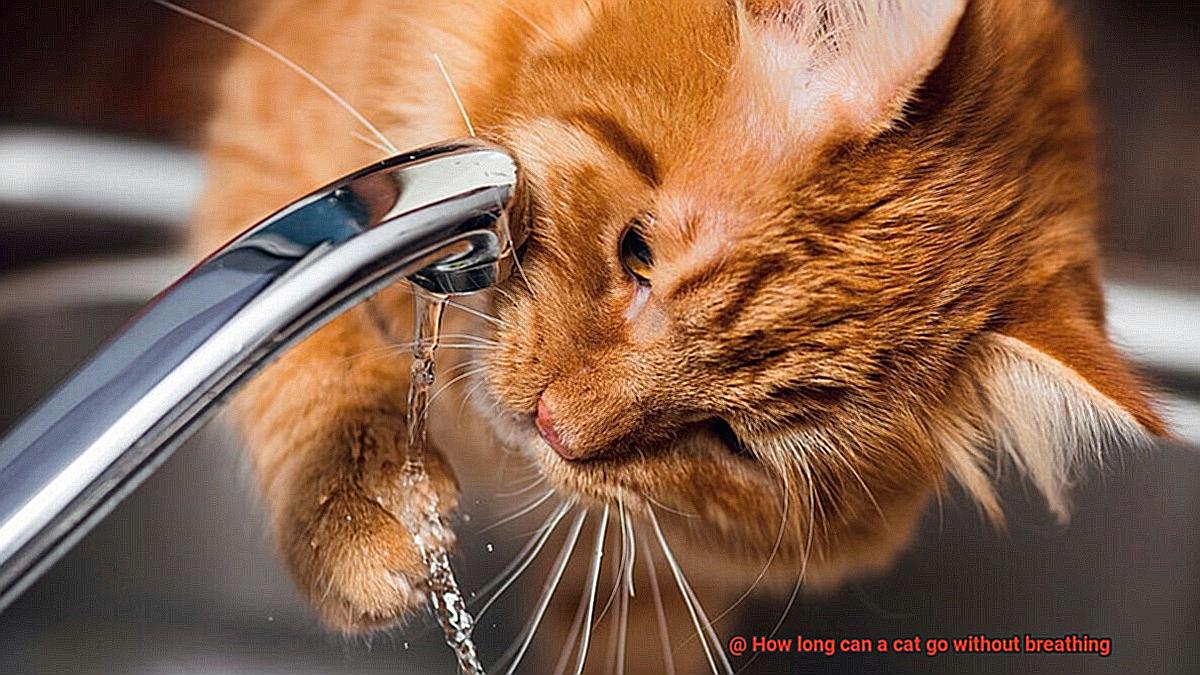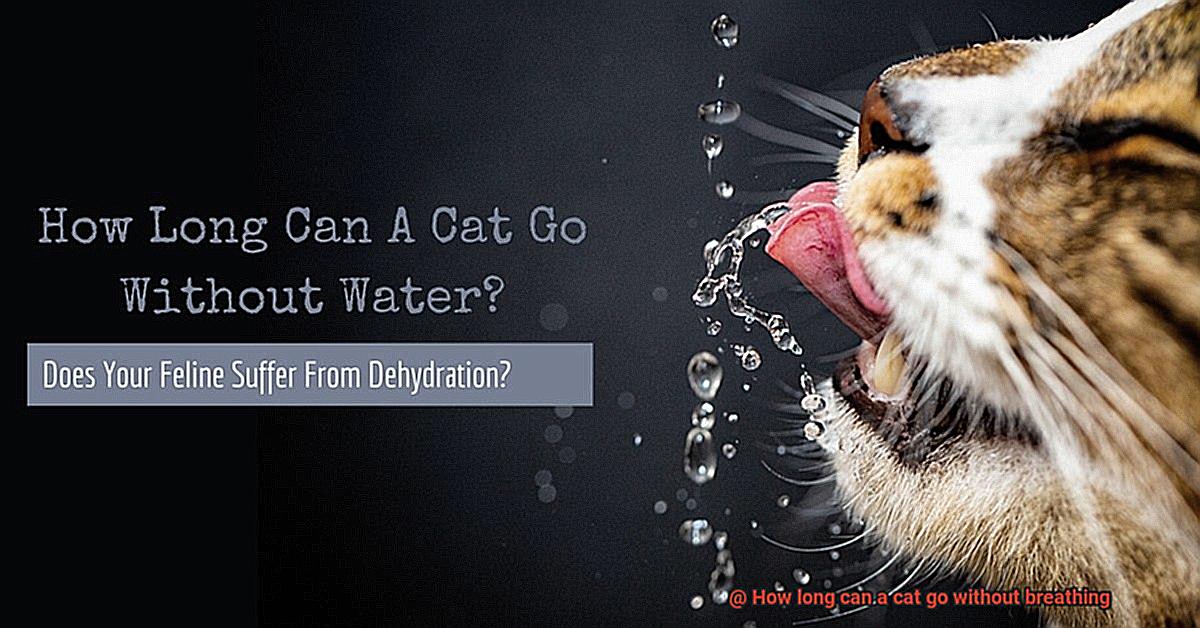Have you ever wondered how long a cat can go without breathing? It may seem like a grim topic, but as a pet owner or animal lover, it’s crucial to know about the potential dangers that your furry friend could face. Just like humans, cats depend on oxygen to survive, and a lack of it can have severe consequences.
In this article, we’ll delve into the subject of how long cats can live without air and explore the various factors that impact this timeframe. But it’s not just about numbers; understanding why your cat might stop breathing is equally important. We’ll also provide tips on what to do if you find yourself in an emergency situation where your cat is struggling to breathe.
To make sure your cat stays healthy and happy, we’ll also discuss some common signs that indicate respiratory distress and what preventative measures you can take to avoid such situations. So buckle up and get ready for an informative ride through one of the most critical aspects of cat care.
Overview of a Cat’s Respiratory System
The respiratory system of cats is a complex and fascinating network that ensures the delivery of oxygen to all parts of their body. This system consists of several interconnected components, including the nose, mouth, throat, trachea, lungs, and diaphragm.
The nose and mouth serve as the entry points for air into the respiratory system. From here, air passes through the throat and into the trachea, which is a tube made of cartilage that connects the throat to the lungs. The trachea then splits into two smaller tubes called bronchi, which enter each lung.
Inside the lungs, there are multiple lobes that are filled with tiny sacs called alveoli. These tiny sacs provide ample surface area for gas exchange to occur – oxygen enters the bloodstream while carbon dioxide is removed.
The diaphragm is a large muscle located at the base of the chest cavity. It plays a critical role in breathing by contracting and relaxing to move air in and out of the lungs. The diaphragm works in tandem with other muscles in the chest wall to ensure efficient breathing.

Although a cat’s respiratory system shares similarities with that of humans, there are some key differences to take note of. For instance, cats have a relatively shorter trachea compared to humans, making them more susceptible to respiratory issues such as asthma or pneumonia. Additionally, their nostrils are much narrower and more sensitive than ours, allowing them to detect even the slightest scent in their environment.
It’s essential to keep an eye out for any signs of respiratory distress in your cat. These may include labored breathing, coughing, wheezing or excessive panting. If you notice any of these symptoms, seek immediate veterinary attention. Quick action can often mean the difference between life and death for a struggling cat.
Normal Breathing Rate in Cats
It’s a crucial aspect to consider when it comes to your cat’s overall health and well-being. Let’s delve into this topic and explore everything you need to know about your feline friend’s respiratory system.
Did you know that cats have a higher respiratory rate than humans? The typical respiratory rate for cats ranges from 16 to 40 breaths per minute. However, this rate can increase when your cat is stressed or excited. So, don’t be alarmed if you notice your cat breathing faster than usual during playtime or a visit to the vet.
Cats are obligate nose breathers, meaning they primarily breathe through their nose and not their mouth. Anything blocking their nasal passage can significantly affect their breathing and lower their oxygen intake. Therefore, always keep an eye on your feline friend’s nasal passages and ensure they are clear.
Various factors can also affect your cat’s breathing rate, such as age, weight, and overall health condition. Older cats or overweight cats may have a higher respiratory rate due to their reduced lung capacity or the extra weight putting pressure on their chest cavity. It’s crucial to monitor your furry friend’s breathing rate regularly and consult with your veterinarian if you notice any changes in their breathing patterns.

Rapid or shallow breathing could indicate an underlying health issue that requires immediate attention. Seeking veterinary care at the earliest signs of respiratory distress can save your cat’s life. Your veterinarian can diagnose and treat any underlying health conditions that may be causing abnormal breathing patterns.
The Dangers of Not Breathing for Cats
Breathing is as essential for our feline friends as it is for us humans. When a cat stops breathing, the consequences can be dire and even life-threatening. The dangers of not breathing for cats cannot be overemphasized, and it’s crucial to understand the various factors that can cause respiratory distress.
Choking is one of the leading causes of breathing difficulties in cats. As curious creatures, cats love to explore their surroundings and may end up swallowing objects they shouldn’t. Foreign objects such as small toys or bones can obstruct their airway, leading to respiratory distress. It’s vital to keep a close eye on your cat’s playtime and keep small objects out of their reach.
Respiratory infections are another common cause of breathing difficulties in cats. Upper respiratory infections caused by viruses or bacteria can lead to inflammation of the airways, making it difficult for cats to breathe normally. These infections can escalate into more severe conditions such as pneumonia if left untreated. Keeping your cat’s vaccinations up-to-date and seeking veterinary care at the earliest signs of respiratory distress can help prevent complications.
Trauma is also a significant cause of respiratory distress in cats. Blunt force trauma or injuries sustained in car accidents can lead to chest wall injuries that impede normal respiration. If your cat has been involved in an accident or suffered a fall, it’s crucial to seek veterinary care immediately.
It’s important to note that underlying medical issues such as asthma or heart disease may also contribute to respiratory distress in cats. Monitoring your cat’s health and seeking veterinary care if you notice any changes in their breathing patterns can help prevent complications.

How Long Can a Cat Go Without Breathing?
The answer is clear: not very long. This is because just like us humans, cats need oxygen to survive, and without it, they can quickly become seriously ill or even die.
In general, a few minutes are all it takes before serious damage occurs. The brain can begin to suffer within just a few minutes of the cat being unable to breathe, and after five minutes without oxygen, permanent brain damage is likely. This means that it is critical to act fast if you notice any breathing difficulties in your furry friend.
However, it’s important to note that the amount of time a cat can go without breathing varies depending on several factors. The age and health of the cat are significant factors in determining how long they can go without oxygen. For instance, if your cat is suffering from respiratory infections or blockages, they may not be able to breathe for as long as a healthy cat with no underlying health issues.
If you notice any signs of respiratory distress in your cat, such as labored breathing or panting, seek veterinary care immediately. Time is of the essence when it comes to these situations, and quick treatment can mean the difference between life and death for your beloved pet.
Prevention is always better than cure; regular vet check-ups help detect any underlying health issues that could cause breathing difficulties in the future. It’s also important to keep an eye on your cat’s breathing regularly, especially if they are prone to respiratory infections or allergies.
Factors Affecting How Long a Cat Can Go Without Breathing
The answer isn’t straightforward, as several factors affect their ability to survive without oxygen.
Firstly, a cat’s overall health is a critical factor in determining how long they can go without breathing. Medical conditions that affect the respiratory system, such as asthma or pneumonia, pose significant risks to your cat’s survival. Similarly, if your cat has a heart condition or any other serious illness, their ability to breathe may be compromised. It’s therefore essential to keep a close eye on your cat’s respiratory health and seek medical attention if necessary.
Age and weight also play an important role in determining how long your cat can survive without oxygen. Older cats and overweight cats may experience breathing difficulties and may not be able to survive for as long without oxygen as younger or healthier cats. Thus, it’s crucial to help your cat maintain a healthy weight and ensure they receive regular check-ups as they age.
Finally, the environment in which your cat finds themselves will also impact how long they can go without breathing. If they’re trapped in a closed space with limited oxygen or exposed to poor air quality due to smoke or toxins, their survival time will be significantly reduced.
Rare Cases Where Cats Have Survived Without Breathing for Longer Periods of Time
Rare cases where cats have survived without breathing for longer periods of time are truly remarkable and showcase the remarkable tenacity of these furry creatures.
One such case was reported by the BBC in 2014 when a cat named Bart was hit by a car and presumed dead. Buried by his owner, Bart dug his way out of the grave five days later and returned home. The cat had no pulse and was barely breathing when he was found, yet he was still alive. This case is nothing short of miraculous and serves as an inspiration to all cat owners.
Another case involved a cat named Tom who fell into a pool and remained underwater for over three minutes. When he was pulled out of the water, Tom was not breathing and had no pulse. However, after several minutes of CPR, Tom began to breathe again and eventually made a full recovery. This case highlights the importance of knowing how to administer CPR to your cat in an emergency situation.
While rare cases like these do exist, it is important to note that they are exceptions rather than the norm. In most cases, if a cat stops breathing, immediate medical attention is required to increase their chances of survival. As responsible cat owners, we must remain vigilant and take care of our furry friends to ensure their health and safety at all times.
Signs That Indicate Respiratory Distress in Cats
Our feline friends are masters at hiding their discomfort, but when it comes to breathing difficulties, there are some unmistakable indicators that your cat needs immediate veterinary attention.
One of the most visible symptoms of respiratory distress is rapid breathing or panting. If your cat’s chest is heaving up and down with each breath, this could be a clear sign that they’re struggling to breathe. Wheezing or coughing are also common symptoms, as well as open-mouth breathing.
In addition to these physical symptoms, pay attention to changes in your cat’s gum color. If their gums appear blue or pale, this could mean that they’re not getting enough oxygen. Lethargy is another prominent symptom of respiratory distress, as your cat may become too weak or tired to move around like they normally would.
But it’s not just physical changes that you should look out for. Behavioral changes can also indicate respiratory distress in cats. Your cat may become more irritable or restless due to pain or discomfort, or they may retreat to a quiet location to rest.
If you suspect that your cat is experiencing any of these symptoms, don’t wait to seek veterinary care. Respiratory distress can be life-threatening and requires immediate intervention. Remember, cats may be tough creatures, but they rely on us to keep them healthy and safe.
It’s important to note that these symptoms can indicate other health issues as well, so it’s crucial to seek veterinary care as soon as possible to determine the root cause of your cat’s breathing difficulties. Early detection and treatment can make all the difference in ensuring your furry friend’s health and well-being.
To sum up, signs of respiratory distress in cats include:
- Rapid breathing or panting
- Wheezing or coughing
- Open-mouth breathing
- Blue or pale gums
- Lethargy
- Irritability or restlessness
- Retreating to a quiet location to rest

What to Do If Your Cat Is Not Breathing Properly
If you suspect that your cat is not breathing properly, there are several steps you can take to help them. Below are five sub-sections that will guide you on what to do:

Assess Your Cat’s Breathing
The first step is to assess your cat’s breathing. Carefully observe any signs such as open-mouth breathing, wheezing, gasping for air, or a blue tint to their gums or tongue. It’s crucial to act quickly and seek immediate veterinary attention if you notice any of these symptoms.

Call Your Veterinarian

Immediately call your veterinarian or emergency animal hospital if you suspect that your cat is not breathing properly. They can provide guidance and may even instruct you on how to perform CPR on your cat if necessary.
Keep Your Cat Calm and Still

While waiting for help to arrive, it’s important to keep your cat calm and still. Any excessive movement could further impair their breathing. Try to reassure your cat with a gentle voice and keep them in a comfortable position.
Check for Obstructions
Check your cat’s mouth and throat for any obstructions such as foreign objects or vomit that could be blocking their airway. If you see something, try to gently remove it with your fingers or a pair of tweezers. However, it’s important not to force anything down your cat’s throat as it could cause more harm than good.
Get Veterinary Attention
Remember, the most important thing to do if your cat is not breathing properly is to seek professional medical attention immediately. Time is of the essence when it comes to respiratory distress in cats. Your veterinarian may provide oxygen therapy or other treatments to help your cat breathe more easily.
M9O6KauPj6o” >
Conclusion
All pet owners and animal lovers must understand the importance of knowing how long a cat can go without breathing. Oxygen is vital for cats, just like it is for humans, and any lack of it can have severe consequences. A cat’s respiratory system is both complex and fascinating, consisting of several interconnected components that ensure the delivery of oxygen to all parts of their body.
Keep an eye out for any signs of respiratory distress in your cat, such as labored breathing or excessive panting. Seeking immediate veterinary attention is crucial if you notice any symptoms because quick action can often mean the difference between life and death for a struggling cat.
Prevention is always better than cure; regular vet check-ups help detect any underlying health issues that could cause breathing difficulties in the future. Additionally, keeping an eye on your cat’s breathing regularly is essential, particularly if they are prone to respiratory infections or allergies.
It’s important to note that the amount of time a cat can go without breathing varies depending on several factors such as age, weight, overall health condition, and environmental factors. If you suspect that your cat is not breathing correctly, assess their breathing and call your veterinarian immediately. While waiting for help to arrive, keep your cat calm and still while checking their mouth and throat for obstructions.
In conclusion, understanding how long a cat can go without breathing is crucial information for every pet owner. By being vigilant about our feline friends’ respiratory health and taking prompt action when necessary, we can ensure they live happy and healthy lives.

